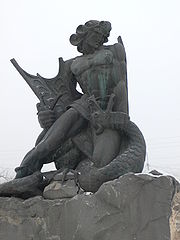
Vahagn
Encyclopedia

Armenia
Armenia , officially the Republic of Armenia , is a landlocked mountainous country in the Caucasus region of Eurasia...
. Some time in his existence, he formed a "triad" with Aramazd
Aramazd
Aramazd is the principal deity in Armenia's pre-Christian pantheon. He was considered the father of all gods and goddesses, the creator of heaven and earth. Aramazd was the source of earth’s fertility, making it fruitful and bountiful. The celebration in his honor was called Amanor, or New Year,...
and Anahit
Anahit
Anahit was the goddess of fertility and healing, wisdom and water in Armenian mythology. In early periods she was the goddess of war. By the 5th century BC she was the main deity in Armenia along with Aramazd.- Temples dedicated to Anahit :...
. Vahagn was identified with the Greek
Greek mythology
Greek mythology is the body of myths and legends belonging to the ancient Greeks, concerning their gods and heroes, the nature of the world, and the origins and significance of their own cult and ritual practices. They were a part of religion in ancient Greece...
Heracles
Heracles
Heracles ,born Alcaeus or Alcides , was a divine hero in Greek mythology, the son of Zeus and Alcmene, foster son of Amphitryon and great-grandson of Perseus...
. The priests of Vahévahian temple, who claimed Vahagn as their own ancestor, placed a statue of the Greek hero in their sanctuary. In the Armenian translation of the Bible, "Heracles, worshipped at Tyr" is renamed "Vahagn".
All the gods, according to the Euhemerist belief, had been living men; Vahagn likewise, was introduced within the ranks of the Armenian kings, as the son of Yervand
Orontid Dynasty
The Orontid Dynasty The Orontid Dynasty The Orontid Dynasty (also known by their native name, Yervanduni was a hereditary Armenian dynasty and the rulers of the successor state to the Iron Age kingdom of Ararat...
(6th century B.C.), together with his brothers — Bab and Tiran.
Historian Khorenatsi's report of an ancient song gives a clue to his nature and origin:
Ancient Armenian origin of Vahagn's birth song
- In travail were heaven and earth,
- In travail, too, the purple sea!
- The travail held in the sea the small red reed.
- Through the hollow of the stalk came forth smoke,
- Through the hollow of the stalk came forth flame,
- And out of the flame a youth ran!
- Fiery hair had he,
- Ay, too, he had flaming beard,
- And his eyes, they were as suns!
Other parts of the song, now lost, said that Vahagn fought and conquered dragons, hence his title Vishabakagh, "dragon reaper", where dragons in Armenian lore are identified as "Vishaps". He was invoked as a god of courage, later identified with Herakles. He was also a sun-god, rival of Baal-shamin and Mihr
Mithra
Mithra is the Zoroastrian divinity of covenant and oath. In addition to being the divinity of contracts, Mithra is also a judicial figure, an all-seeing protector of Truth, and the guardian of cattle, the harvest and of The Waters....
.
The Vahagnian song was sung to the accompaniment of the lyre by the bards of Goghten (modern Akulis), long after the conversion of Armenia to Christianity.
The stalk or reed, key to the situation, is an important word in Indo-European mythology, in connection with fire in its three forms.
The name, originally Verethragna
Vahram
Verethragna is an Avestan language neuter noun literally meaning "smiting of resistance" . Representing this concept is the divinity Verethragna, who is the hypostasis of "victory", and "as a giver of victory Verethragna plainly enjoyed the greatest popularity of old" .The neuter noun verethragna...
, the hypostasis of victory in the texts of the Avesta
Avesta
The Avesta is the primary collection of sacred texts of Zoroastrianism, composed in the Avestan language.-Early transmission:The texts of the Avesta — which are all in the Avestan language — were composed over the course of several hundred years. The most important portion, the Gathas,...
, turned into Vahagn (the Avestan
Avestan language
Avestan is an East Iranian language known only from its use as the language of Zoroastrian scripture, i.e. the Avesta, from which it derives its name...
"th" becoming "h" in Arsacid Middle Persian
Middle Persian
Middle Persian , indigenously known as "Pârsig" sometimes referred to as Pahlavi or Pehlevi, is the Middle Iranian language/ethnolect of Southwestern Iran that during Sassanid times became a prestige dialect and so came to be spoken in other regions as well. Middle Persian is classified as a...
), later on to take the form of Vahagn. See Վահագն for more on the origin of the name.
External links and references
- A History of Armenia (Armenian Mythology) by Vahan M. Kurkjian. Published by the Armenian General Benevolent Union of America 1958/YR.

